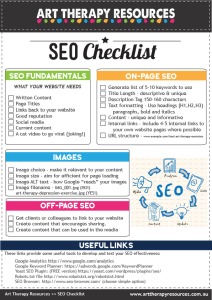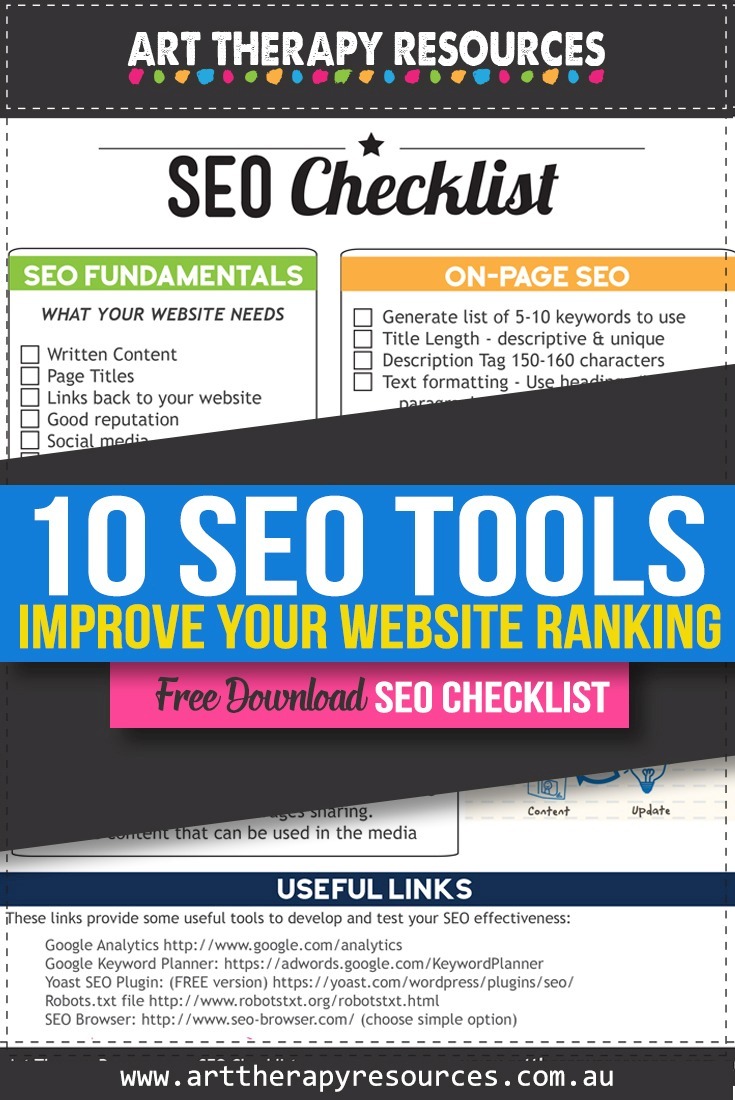THIS POST INCLUDES:
1. What is SEO
2. Why is SEO important
3. Steps to improve SEO
4. 10 SEO Tools
5. Free Download SEO Checklist
WHAT IS SEO
SEO covers all kinds of content on your website including written content, audio, video, and images. Written content is the most obvious searchable content on your website, however other visual and audio media should be included in your SEO tactics as they now represent important content that should be included on a website.
As the internet has grown in complexity, readers have been able to search for content based on their preferred method of absorbing content – written, visual, auditory.
WHY IS SEO IMPORTANT
SEO is also an important part of your overall marketing strategy. If you have good searchable and readable content on your website, then your website is considered a useful tool for potential readers. The more your website is considered as useful, the more search engines like Google will allocate you with better rankings.
SEARCH TERMS
Think about when you search for a term on the internet. You may enter the search term ‘art therapy anxiety’ into Google and not give too much thought into why and how Google presents you with the options it does.
Most people who conduct searches online usually only look at the first page of results after entering their search term. From this perspective, it’s an ideal situation to have your website presented in the results on the first page for search terms that are relevant to your therapy practice and services.
If you live in Sydney, Sacramento or Singapore, you want your website to appear high on the list of search results if someone enters the terms:
- art therapist sydney
- art therapist sacramento
- art therapist singapore
SEO TO FIND CLIENTS
Your website will appear in search results if the search terms that potential readers use exist within the content on your website. If a potential reader is searching online for “how to reduce anxiety” then your website will match that search if you also include that term “how to reduce anxiety” on your website.
It’s great if you have a blog post that exactly matches that term, however, your blog title may be “How to reduce anxiety with art therapy”. Even though your title included extra words “…with art therapy”, it still included the most important search term – “how to reduce anxiety”.
You may wonder how you ensure that your blog post titles use search terms that potential readers are using? To solve this problem, it’s important that you are aware of what your clients are looking for when they search online.
As an art therapist you possess a wealth of knowledge on art therapy and psychological terms, however, it’s important that you write with language on your blog that your client can relate to. This requires a balance of using terminology and language that references your specialties but also uses language that reflects what a typical client of yours might use.
It’s helpful to use a variety of techniques when using SEO as a marketing strategy. This includes understanding what stage of the process your client is with their search.
The below three stages are the most common stages of a client who may be looking for your services:
SOLVING A PROBLEM:
The first stage entails the potential client recognising they have a problem that they are looking to solve. This may be dealing with anxiety, depression, grief, or specific life events. Usually, at this stage, a potential client will be looking for solutions online and may not be completely ready to book a therapy appointment.
In this situation, it’s important that you include content on your website that will attract the attention of potential clients who just want to learn about solving their problem before making a commitment to an appointment. Therefore it’s important that you don’t only include content on your website that focuses solely on booking appointments.
Typical search terms a potential client may use in this stage include: how to reduce anxiety
CONSIDERING OPTIONS:
At this stage of the process, your potential client may have educated themselves on their problem and the possible solutions that exist. They may now be considering whether therapy can help them and what therapy entails. From this perspective, your website should include content that addresses your potential clients fears, worries, and concerns about attending therapy. You may want to detail how you run a session and any common fears you know your client may have that you have helped other clients address as part of an art therapy session.
Typical search terms a potential client may use in this stage include: what happens in art therapy, does art therapy work
MAKING A PURCHASE:
At this final stage of the search process, your potential client is looking to book a therapy session in their area. To help improve your website appearing in their search results you should include terms on your website that will resemble the type of searches they might use to find someone in their location.
Typical search terms a potential client may use include: art therapist sydney, art therapist singapore, art therapy groups, counselor anxiety sacramento
*locations used as examples
STEPS TO IMPROVE SEO
- Publish regular content that attracts your potential client
- Optimize page speed loading so that your potential client can use your website with limited frustration
- Your website should be mobile friendly. Statistics show as much as 51% of potential readers will find your website through the use of their mobile device (phone or iPad/tablet)
- Image optimization – name your image files in the same way you would write content
- Simplify URL structure – use easy URLs that your client can remember and share. For example use www.mywebsite.com/reducing-anxiety instead of www.mywebsite.com/ways-to-reduceanxiety-that-can-help-today (*note: made up URLs as an example)
- Use keywords in your content – use specific words that your potential client will use when searching
10 SEO TOOLS
These tools will help you focus on ensuring your SEO strategy meets the requirements of popular search engines such as Google. The more your website impresses Google search, this means your website will appear higher in the ranking of searches made by potential readers.
Search engines such as Google use automated robots and algorithms to assess your website useability and content relevance. The below tools are designed to function with the algorithms that are used by search engines.
The SEO tools selected below are free to use. There are a number of paid SEO Tools that are considered useful, however, we’ve chosen to focus on free SEO tools only.
- Google Webmaster Tools: search console, analytics, page speed insights, keyword planner
- Gtmetrix
- SEO Quake (browser extension)
- SEO SiteCheckup
- Siteliner
- Hubspot Website Grader
- image optimizer
- Varvy
- XML sitemaps generator
- Yoast WordPress Plugin
You may not want to use all 10 tools. The top 3 tools to consider are:
- Google Webmaster Tools: search console, analytics, page speed insights, keyword planner
- SEO SiteCheckup
- Yoast WordPress Plugin
FREE DOWNLOAD: SEO Checklist

BUILD YOUR ART THERAPY REFERENCE MATERIALS:
Pin this image to your Pinterest board.

SHARE KNOWLEDGE & PASS IT ON:
If you’ve enjoyed this post, please share it on Facebook, Twitter, Pinterest. Thank you!
